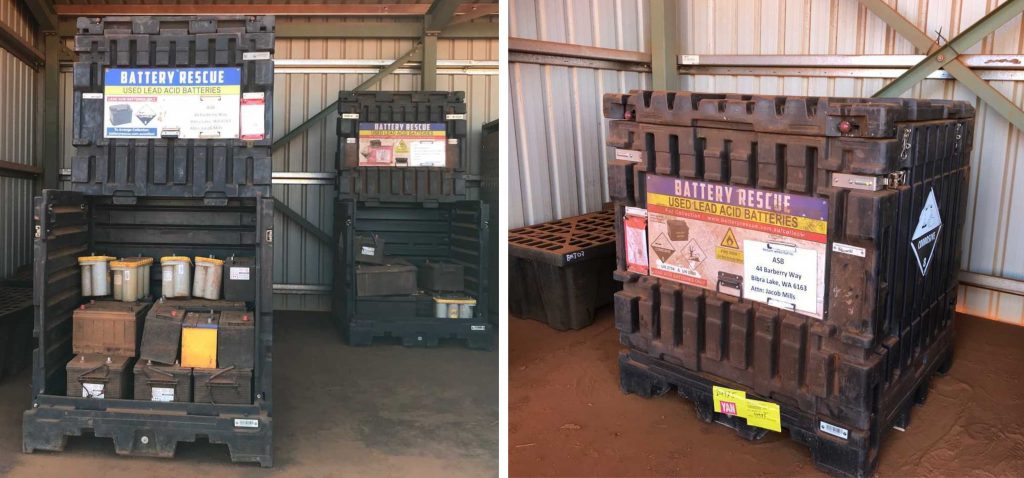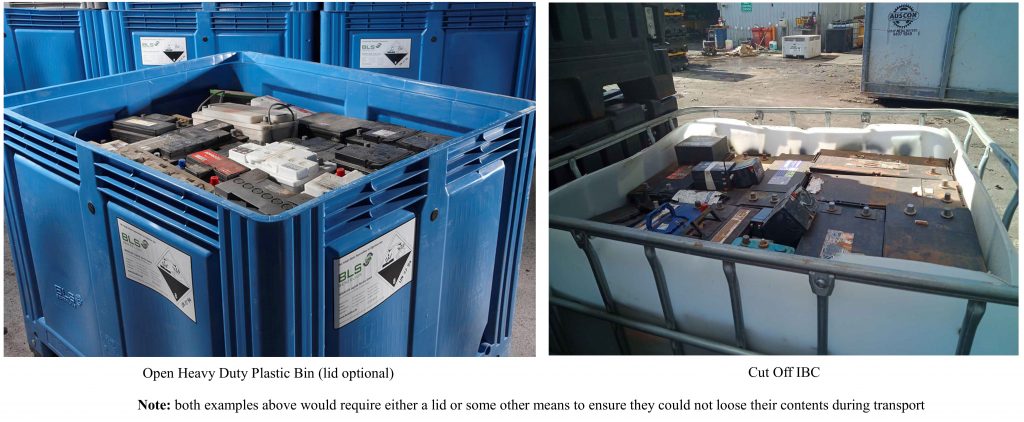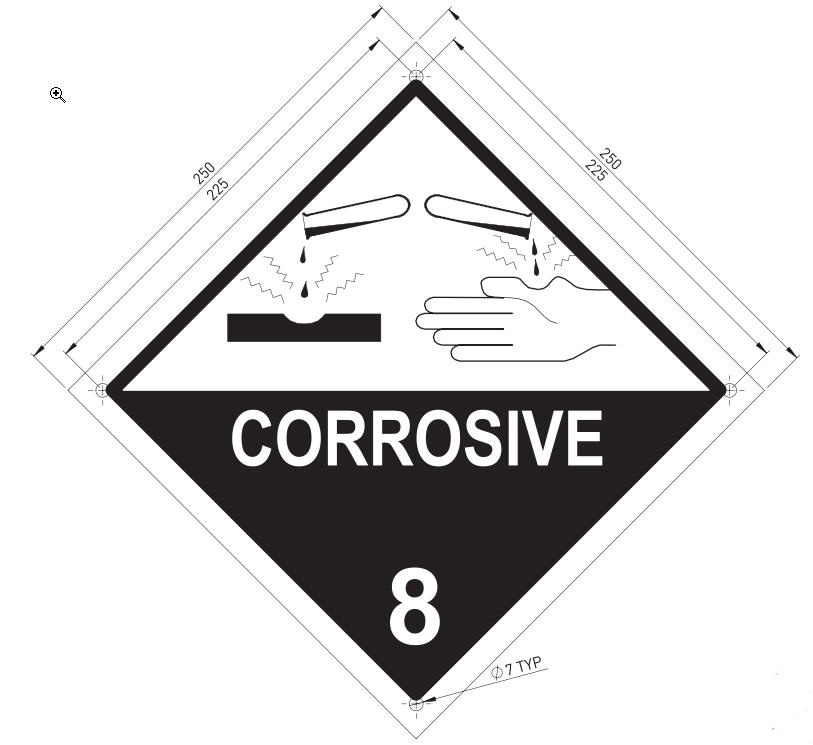As a Controlled Hazardous Waste and Dangerous Good, used lead acid batteries (ULAB) must be stored, handled and transported in accordance with a range of Western Australian and Federal regulations. The majority of these regulations carry significant penalties for non-compliance.
Many companies are unaware of their “Chain of Responsibility” obligations introduced in 2015 WA Road Transport Act. The CoR legislation recognises the responsibilities that others have in the transport of goods by road, beyond just the transport provider and their driver. It means that Consignors, including the Company and its Executives, can be held legally liable if they cause or contribute to road safety breaches.
Not from Western Australia? Check out our overview of Australian regulations controlling new & used lead acid batteries.
Below is a comprehensive summary of the regulations that govern the storage and transport of used lead acid batteries for Western Australian businesses and organisations that generate and dispose of ULAB.
Attention WA Public for Car Battery Disposals
You can ignore these regulations if you have a limited quantity (several) ULAB, such as car batteries, to dispose of. Please however correctly dispose of your used car batteries to ensure they are safely recycled. For details see where & how to dispose of your car battery.
If your a WA business or organisation looking for a convenient used battery collection and recycling service, that is safer, delivers better environmental outcomes and meets your regulatory requirements, please visit our home page.
For details on our Western Australian Regional & Mining battery collection service.
Transporting Lead Acid Batteries by Road or Rail
As a Dangerous Good, the requirements for the transportation of Used Lead Acid Batteries (ULAB) by either road or rail are specified in the “Australian Code for the transportation of Dangerous Goods by Road & Rail” (ADGC). The National Transport Commission‘s (NTC) maintains and updates the code which is enacted in WA’s Dangerous Goods Safety (Road and Rail
Transport of Non-explosives) Regulations 2007
The WA Department of Mines, Industry Regulation Safety (DMIRS) is responsible for administering and enforcement of the ADGC in Western Australia.
In addition to the ADGC requirements, the transport of ULABs also need to meet the safe and appropriate operation of a heavy vehicle on WA roads and load restraint guides regulated by Mainroads Western Australia.
Used Lead Acid Batteries are also classified as a Hazardous Waste and hence their transportation is also controlled by the “WA Environmental Protection (Controlled Waste) Regulations 2004“
Changes to the ADGC for the Transport of Lead Acid Batteries
New regulations governing the transportation of lead acid batteries (new & used) were adopted in edition 7.7 of the ADGC and became mandatory in October 2021.
There have been significant changes made to the P801 Packing Instruction, which is shown below;.
You can download a printable copy here of the revised ADGC P801 Packing Instruction.
The main change to the P801 is the inclusion of requirements for transporting used lead acid batteries (ULAB) in either stainless steel or plastic bins. These changes were introduced to remove the ambiguity as to whether the “additional requirements” in the current P801 Packing Instructions applied to ULABs being transported in bins.
The Australian Special Provision AU08, has also been modified in this edition. AU08 clarifies that it is the acid volume contained in the batteries that is used to define the aggregate quantity of dangerous goods (DG) in the load. If the acid volume is not known, usually the case for used batteries, a nominal figure of 25% of the gross weight of the batteries may be used.
Under the ADGC placard load requirements an aggregate quantity of 1000L of acid requires vehicle placarding. Using the 25% calculation, this means that quantities of more than 4000kg of used lead acid batteries would require DG placarding of the transport vehicle.
What are the ADGC packaging requirements for wood pallets?
If you are using wood pallets, referred to as an overpack in the ADGC, then your packaged lead acid batteries should appear like the example below. It shows 30mm Cardboard being used to separate each layer (clause 1b) to prevent battery terminals damaging overlying batteries and the application of plastic wrapping and multiple straps to secure the load to the heavy-duty pallet.
What are the ADGC packaging requirements for plastic bins / containers?
If you are using plastic bins or cut off IBC like those shown below, to transport ULAB take steps to ensure that clauses 2b) and 2e) of the new P801 packing instruction are met (shown above). Also clause 2d) requires that no electrolyte shall leak from the bins. This can be an issue with cut off IBC which are prone to develop leaks, when heavy batteries are dropped into the container.
Battery Rescue’s BTS Container, pictured below, contains a permanently attached lid, so automatically meets the requirements of clause 2b) and 2e).

Clause 2f) states that “Measures shall be taken to prevent short circuits (e.g. batteries are discharged, individual protection of the battery terminals, etc.)”. As is usually the case the regulations don’t tell you how this should be done, although in this case they make a couple of suggestions, which don’t appear to be very practical.
For the majority of batteries, with plastic casing, the risk of short circuits can be eliminated by stacking each battery in a vertical, upright position, whereby the plastic bottom of the battery is resting on the terminals of the underlying battery. Provided the batteries are packed snugly the batteries will continue to remain in the upright position during transport and there will be no risk terminals touching each other and creating the conditions for a short circuit.
Steel case batteries and metal encased UPS’ require additional packing precautions as their metal cases can create a short circuit when resting on the terminals of an underlying battery. Our recommendation is that these batteries are stacked at the bottom of the Bin / Container so that they never make contact with other battery terminals or adequate insulation, such as a folded card board box, is placed between the underlying battery and the steel case battery.
What are the other ADGC requirements?
Labeling
- 2 Class 8 Corrosive Diamonds, minimum size of 100 x 100mm with minimum lettering size of 7mm, applied to opposite side of the package.
- All packages must be labeled with the UN Number 2794, proper shipping name “BATTERIES, WET, FILLED WITH ACID, electric storage”. Minimum 12mm lettering size.
- All packages must display the Name, address and contact number of the consignor. Minimum 12mm lettering size.
Note: It is an offence under the ADGC to transport an empty bin or container while displaying DG labels.
Load Restraint
- Packages (i.e. pallets, bins, IBC etc) must be stowed & restrained in the vehicle in accordance with the National Transport Commission’s Load Restraint Guide 2004.
- In addition Chapter 9.2 of the ADGC requires that batteries being transported with incompatible dangerous goods or other goods, must be segregated. Note that when batteries are transported with other goods all goods must be restrained to prevent damage to the batteries and release of their electrolyte.
- If batteries are transported in an open or non-rigid sided vehicle (includes curtain sided vehicles), the battery packages must be;
- stowed & restrained within rigid sides or gates.
- no package or battery may protrude above the sides or gates by more than 30% of the height of the battery or package.
- no parts of a battery or package may protrude horizontally beyond the side gates.
- For further details read Chapter 8.1 of the ADGC.
Dangerous Good Transport Documentation
- The Consignor who provides the ULAB for transport shall provide the transport contractor information applicable to those dangerous goods.
- The documentation must be carried in the vehicle in hard copy form
- The documentation must include the name and address of the consignor, consignee, including the consignor’s contact telephone number
- The documentation should include the following information
- UN Number – UN2794
- Proper Shipping Name – BATTERIES, WET, FILLED WITH ACID, electric storage
- DG Class – 8
- Description of Packages – i.e. Pallet, Bulk Bin, IBC
- The number of each type of package
- The aggregate quantity of battery acid. If unknown use nominal figure of 25% of gross weight of batteries (as per Australian Special Provision AU08)
You can download here an example of the DG Transport Document for transporting Wet, Lead Acid Batteries (UN2794).
Emergency Information
The vehicle used to transport the dangerous goods, must carry the DG documentation, described above, and emergency information, as follows ;
- If a placard load (more than 4000kg of batteries) the vehicle must be fitted with an Emergency Information Holder otherwise documentation can be kept in a prominent location in the the cabin.
- Emergency documentation should include an Initial Emergency Response Guide, an Emergency Procedure Guide for the dangerous good, an Emergency Procedure Guide in relation to a vehicle fire.
- See Chapter 11.2 – Emergence Information in ADGC for further details.
Vehicle Placarding
Placarding of the transport vehicle is only required if carrying a placardable load (more than 1000L of electrolyte ~4000kg of used lead acid batteries). Fixed/Rigid vehicles, the placarding required is a 250 x 250mm Corrosive diamond to be displayed at the front and rear of the vehicle. For placarding requirements when transporting batteries using a semi-trailer, see Figure 5.3.6 in the ADGC.
What are the Hazardous Waste Transport Requirements for ULAB?
Used lead acid batteries are also classified as a controlled hazardous waste, with their storage & transportation regulated by the “WA Environmental Protection (Controlled Waste) Regulations 2004“. The Department of Water and Environmental Regulation (DWER) regulates the transportation of controlled waste on roads in Western Australia.
Controlled waste transport requirements for ULAB include;
- The Carrier must be licensed as a controlled waste carrier. With the Carrier having also registered the names of their drivers with DWER.
- The vehicle used to transport the ULAB must display a sign on both side and the rear of the vehicle, that states the following (in at least 50mm);
- “Controlled Waste”
- The name of the Carrier
- The Carrier’s license number
- The vehicle must fitted with rigid sides or gates.
- The Carrier must have a a documented spill management plan and spill management equipment that must accompany the vehicle transporting the ULAB.
- Each packaged unit of ULAB is clearly labelled with the waste code “D221” and Waste Name “Used Lead Acid Batteries”.
Note: Used Lead Acid Batteries do not require a Controlled Waste Tracking form (unlike most Hazardous Waste).
Full details of Waste Holders (i.e Consignors) obligations can be found in DWER’s “Requirements for Waste Holders” fact sheet
Storage & Handling Requirements for Used Lead Acid Batteries
Western Australian regulations that cover the storage of used lead acid batteries (ULAB), include;
- “WA Dangerous Goods Safety (Storage and Handling of Non-explosives) Regulations 2007”, which is administered by the Department Of Mines, Industrial Regulations and Safety (DMIRS).
- “WA Occupational Safety and Health Regulations 1996” which cover safety issues such as “Risk from exposure to hazardous substances” and “Manual Handling” safety. These regulations are administered by WorkSafe, which is now a division of DMIRS.
- “Environmental Protection Regulations 1987” regulates the storage of Hazardous Waste and is administered by the Department of Water & Environmental Regulations.
- “WA Environmental Protection (Unauthorised Discharge) Regulations 2004” regulates the discharge of hazardous substances into the environment. The regulations are administered by local government councils.
The key requirements of these regulations are detailed below;
WA Dangerous Goods Safety Regulations 2007
These regulations includes a test as to whether a site is a “small quantity dangerous goods location” or “dangerous goods site”. A “Dangerous Goods Site” must apply and be granted a license. Assuming that ULAB are the only DG at the site, then a site is deemed as a “dangerous goods site”, if;
The site maintains more than 1000 L of battery electrolyte (referred to as placard quantity) . This is equivalent to approximately 4000 kg of ULAB. The exceptions to the above are;
- If the ULAB are stored in more than one storage area and the quantity stored in each area is less than 4000 kg.
- Each storage area, is outdoors or in a separate building or underground area in which only the ULAB are stored.
- Each storage area is sufficiently separated that an incident at one storage area could not impact another storage area.
- There are also additional exemptions for temporary storage (not more than 6 months), please refer to Part 4 – Dangerous Goods Sites, item 25-3 for full details, if this is relevant.
A site that doesn’t meet the above criteria is classified as “small quantity dangerous goods location”. The extensive requirements for “dangerous goods sites” are not covered here, please refer to Part 4 – Dangerous Goods Sites, of the regulations.
Below is a summary of the key requirements for a “small quantity dangerous goods location” storing and handling ULAB. The Occupier of the site, must;
- Ensure any spill of battery electrolyte is cleaned up and disposed of, as soon as practical.
- Ensure that the ULAB cannot interact with incompatible goods or contaminate other goods.
- That the ULAB are protected from impact
- Does not accept delivery of ULAB that do not comply with the Australian Code for Transportation of Dangerous Goods (ADGC).
- Maintain personal protective equipment (PPE) or safety equipment that is suitable for storing & handling the ULAB (we would recommend gloves, safety glasses, steel tipped worked boots, suitable work wear & spill kit as a minimum).
- Maintain a SDS for the ULAB in a readily accessible location.
- Any person who is involved in the storage & handling of the ULAB are provided with appropriate training & supervision, that;
- identifies the hazards and risk associated with ULAB and how these risks are to be controlled.
- the location, proper use and maintenance of relevant PPE and safety equipment.
WA Occupational Safety and Health Regulations 1996
Workplace safety and health in Western Australian workplaces is regulated by the Occupational Safety and Health Act 1984 and the Occupational Safety and Health Regulations 1996. You can download a list of the key Workplace Safety requirements that are applicable for used lead acid batteries.
In February 2020 the Western Australian Government approved the development of a Work Health and Safety Bill that will modernise and consolidate WA workplace health and safety regulations. The bill is designed to bring our regulations in line with national regulations and to replace 3 acts, the Occupational Safety and Health Act 1984, Mines Safety and Inspection Act 1994; and Petroleum and Geothermal Energy Safety Levies Act 2011. A time frame for the development of the new workplace health and safety regulations has not been provided.
Environmental Protection Regulations 1987
If you store and handle more than 500 Tonnes of ULAB per year then you will need to apply under the Environmental Protection Regulations 1987, as a category 62 Prescribed Premises . There may also be a requirement to register your business with your local council.
WA Environmental Protection (Unauthorised Discharge) Regulations 2004
Under the “WA Environmental Protection (Unauthorised Discharges) Regulations 2004” it is an offence to allow acids to discharge into the environment. Your Used Lead Acid Batteries should be stored in a bunded area (or device) and undercover to prevent the occurrence of an unauthorised discharge event.
Other Useful Resources
- “WA Road Traffic (Vehicles) Act 2012” and “Chain of Responsibility” provisions for WA Transport Laws. Administered by WA Main Roads.
- Australian Standard for Storing & Handling Corrosives 3780:2008 – This publication can be purchased from a number of online providers. Section 2 deals with provisions for Minor Storage, which applies if the combined volume of acid contained by the batteries is less than 1000L.
- Century Batteries, Safety Data Sheet for Lead Acid Batteries.
- The Australian Battery Recycling Initiative (ABRI), is an industry body established to promote the collection, recycling and safe disposal of all batteries. ABRI has published several useful documents outlining the regulatory requirements and “best practice” recommendations for the storage, handling and transportation of ULAB.





